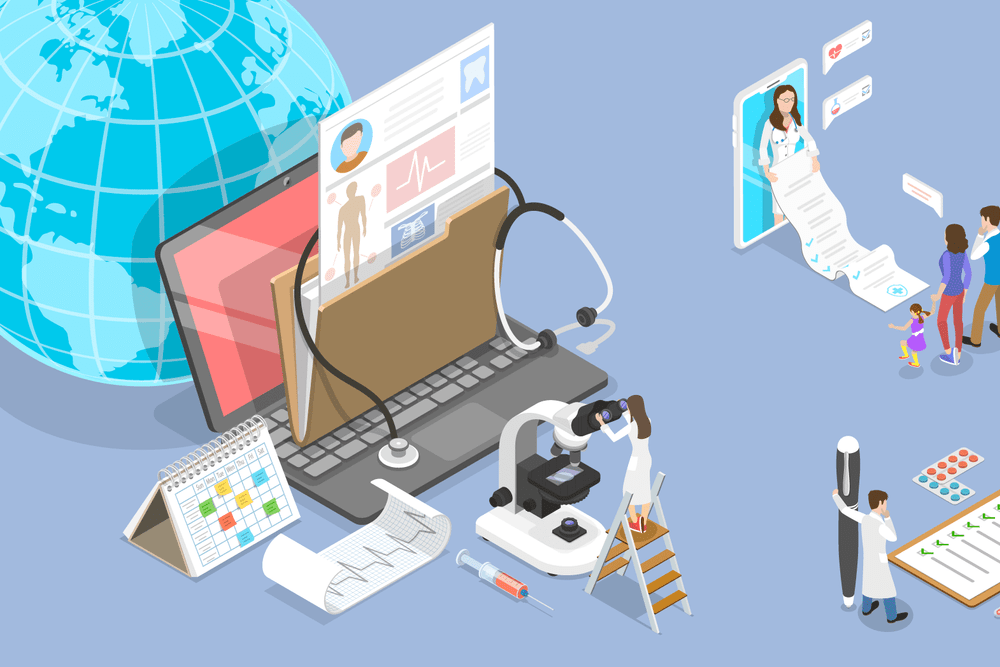Electronic health records (EHR) and practice management software are two popular applications used by healthcare practices. The two applications seek to improve healthcare facility productivity and efficiency, but they have many differences and target different areas. The applications are optimized for various practices, so you can find dermatology, ophthalmology, plastic surgery, and orthopedic EHR software applications. Here’s an overview of the differences between EHR and practice management software for healthcare facilities:
What Is Practice Management Software?
Practice management software assists with office administrative work, meaning the day-to-day operations of a healthcare organization. The software bridges gaps between clinical work, such as diagnosis reports, procedure codes, patient appointments, insurance verification, and medical billing. Practice management software includes features that manage patient information, but the application is geared toward the facility’s clerical work. The software streamlines patient flow management and general documentation rather than dealing with medical history.
What Is Electronic Health Record Software?
EHR software is used by physicians to track information about their patients. The software documents and stores patient medical information. EHR software can help manage patient medical histories, allergy information, diagnosis coding, test results, and other patient treatment lifecycle info. It also allows healthcare providers to share information across departments electronically rather than physically. EHR software can help reduce errors and legibility issues that afflict manual data entry. The software is meant to help manage patient information rather than assist in administrative management.
How Are the Two Different?
EHR and practice management software can both be used within the same practice for different purposes. Practice management software is about administrative and office work, while EHR focuses on patient medical information documentation. Because of the different focuses, the applications have distinct features, benefits, and target outcomes. Here’s an overview of three main differences between electronic health records and practice management software applications:
1. Different Features
Practice management and EHR software have different features to help them meet their differing goals. EHR software has features to optimize the charting process for physicians in all fields. This allows them to more quickly document observations about patients and spend more time with the patients themselves. This also allows physicians to review patient medical histories and information from previous visits that may be relevant. The features can change depending on the practice, so an orthopedic EHR may have different features from one used for a plastic surgery practice.
Practice management software allows a practice to manage the clerical work and provide a more consistent experience for patients. With practice management software, patients can make appointments through a patient portal. In the same portal, they can pay bills and review their medical information. Practices that employ this software are able to access data about appointments and track patient leads, if necessary. These marketing and data analysis tools can help a practice analyze the trends of its service and make more informed decisions moving forward.
2. Different Benefits
EHR and practice management software both have the inherent benefits of computer-based applications, such as automation, accuracy, and a reduction in paperwork. They also have benefits specific to their roles and functions. Practice management software can save time for employees and patients as it makes scheduling and billing much easier. It can also increase the overall efficiency of a practice, reduce no-shows, and improve communication. The centralized system is user-friendly, comprehensive, and customizable, so you can find optimal features for your practice.
EHR software can reduce the amount of time a physician must spend charting and reviewing patient data. This allows them to spend more time with their patients and less time looking around for files. It can also improve documentation accuracy, increase charting efficiency, improve workflow, and regulate performance monitoring. Many EHR software options allow physicians to automatically generate letters for quick referrals. Patient information sharing is also made easier through a simple, user-friendly interface. EHR software seeks to improve patient record management, while practice management improves clerical work.
3. Different End Users & Incentivization
EHR and practice management software applications have different end users. Front desk workers who don’t need to access patient medical history are the ideal users of practice management systems. Practice managament systems are also used by patients in the form of a patient portal, where patients can make appointments and pay bils. EHR systems are used only by physicians, dentists, surgeons, orthopedics, and nurses who need access to the patient’s medical information. The utility of EHR and practice management software can overlap, but most systems have access restrictions.
The government incentivizes healthcare facilities to use electronic health records to increase service quality. Eligible practices can receive thousands of dollars for implementing EHR systems, which isn’t the case for practice management. The government is more willing to assist with funding EHR software because it improves healthcare services geared toward patients.
Premium Orthopedic EHR and Practice Management Software
Healthcare practices can use EHR and practice management software to improve their services for patients and make their processes more efficient and less prone to error. Regardless of the type of practice you work in, this software can be customized for your operation and lead to great outcomes for patients and healthcare providers alike.
- Understanding Backflow Testing and Annual Fire Alarm Inspections: Essential for Safety and Compliance - April 1, 2025
- Preamplifiers – Significance, Types, Benefits - January 10, 2025
- The Science of Bass: Understanding How Subwoofers Work - January 10, 2025

